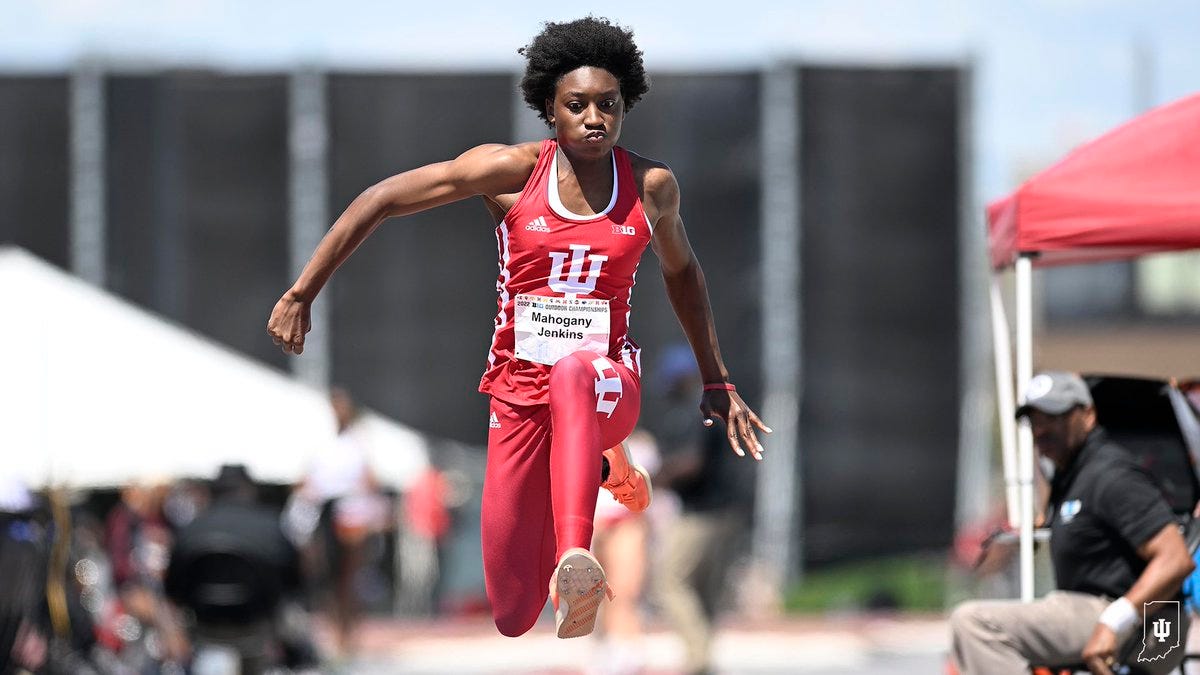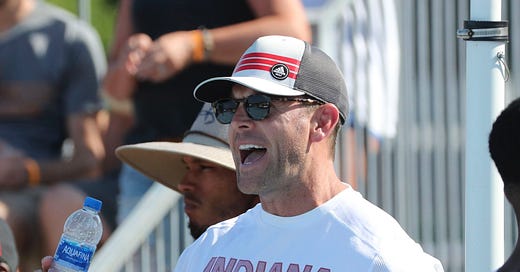IU's Mike Erb: 5 Tips to Increase Consistency on the Runway
Coach Erb's career includes 59 BIG10 Finalists, 10 BIG10 champions, and 8 USTFCCCA All-Americans so yes, he's a big deal.
I like to think of this new segment as a virtual coaches convention that lasts throughout the year with more guests to come!
I’d like to introduce a coach and man I admire who has helped me tremendously throughout my career. It’s an honor to have him join us!
Without further ado…MIKE ERB! 👏👏👏
There isn’t a horizontal jumper on the planet who hasn’t had their share of trouble with consistent steps on the runway. Like our fisherman friends, everyone has a story of the “one that got away”.
As long as there are long and triple jump competitions, there will always be fouls, but let’s take a look at five strategies to increase runup consistency and reduce the likelihood of red flags.
1. Be the best sprinter you can be.
First and foremost, significant time must be spent learning and rehearsing the mechanics of acceleration, transition, and upright running. Good, consistent runways are the result of time spent away from the pit, on the track, mastering the positions and postures necessary for proper sprinting.
The jumper with the highest horizontal velocity on the runway will ultimately jump the farthest. That said, if the run is so fast that an athlete cannot properly execute appropriate takeoff mechanics, then that speed is wasted. What we’re looking for is the maximum manageable speed where appropriate takeoff positions can be maintained.
The jumper with the highest horizontal velocity on the runway will ultimately jump the farthest. - Mike Erb
Sprint mechanics are an entirely different discussion with no shortage of available information, so we won’t get into the weeds here. That said, I find it best to come to the runway already having a good handle on basic sprint mechanics. It can be very difficult to find any kind of consistency on the runway if sprint mechanics aren’t already somewhat polished.
Suffice it to say that better and more proficient sprinters will have an easier time finding the takeoff board.
Eric Bethea - NCAAs 2019
Proficient sprinters will have an easier time finding the takeoff board. - Mike Erb
2. Determine an appropriate approach length.
Approach length is determined through a combination of the total number of steps and the total distance covered by those steps.
Very generally speaking, horizontal jump approach runs typically fall between 12-20 total steps. As a coach, it becomes your job to recognize what length of approach is suitable for your athletes. For example, you’ll likely find taller, longer athletes tend to require more steps to reach an appropriate takeoff velocity, and younger, less experienced athletes tend to perform more consistently with shorter approaches. Triple jump approaches tend to be shorter than long jump approaches.
Once the total number of steps has been determined, take those steps to the track – not the runway – and have the athlete accelerate beyond the predetermined number of steps for several repetitions. By running on the track, outside visual cues (such as the board, pit, etc.) are reduced, and the athlete can better focus on just the run. Beginning from the same place each time, mark where their takeoff step lands on the track. Note: Do not allow the athlete to actually take off on the track, as landing on a hard surface can be extremely dangerous.
The takeoff mark should become relatively consistent, at which point measure the total distance and transfer it to the runway. You’ve got your approach length!

Once the total number of steps has been determined, take those steps to the track – not the runway – and have the athlete accelerate beyond the predetermined number of steps for several repetitions.
3. Determine a mid-mark.
Once on the runway, it can be helpful to find a check mark (or mid, as it’s often called) that a coach uses to fine-tune the approach. Find the mark 4 strides from the takeoff (i.e., if you’ve got a 16 step approach, the mid would be where the 12th step makes contact), and mark this with a cone or tape. Typically, this mark will fall somewhere between 26 and 29 feet from the board for women and 28 and 32 feet from the board for men, regardless of the total approach length.
This mark is a powerful tool to determine where a good runup went well or a bad runup went wrong. Keep in mind that this mark is mostly for the coach, as the athlete should be focused on a quality run and spotting the board. More on this later.
If an athlete is over their mid mark and over the board by a similar amount, the solution could be as simple as moving the athlete’s start mark back the same distance. If they’re over the mid mark but on or behind the board, they might be overly conservative and reduce speed prior to takeoff. If they are behind the mid mark and over the board, then they might be taking steps that are too long (also reducing speed) prior to takeoff.
As a coach, it’s important to see as much of the approach as possible. Very little information can be seen when standing just a few feet from the takeoff board.
Ideally, a coach should observe the jump from a spot 20 or 30 feet away from the runway and somewhere between the mid-mark and takeoff board. From here, it’s much easier to see and make appropriate corrections.
4. Be aware of the board during the approach.
No matter how well rehearsed and consistent the runup, it is nearly impossible for any athlete to make accurate contact within a few inches of a predetermined mark from 80 to 100 to 150 feet away without having some frame of reference of where they are in space.
By spotting the board a few strides out, even if just peripherally, they’ll be able to make small proprioceptive adjustments and increase their accuracy. We’re not talking about giant bounds or tiny stutter steps, but adjusting a stride by just 1 inch over the last few can make the difference between a fair and foul jump with no change in running or takeoff mechanics.
…but adjusting a stride by just 1 inch over the last few can make the difference between a fair and foul jump…

5. Practice. Practice Again.
It should go without saying that consistency in the run comes from a high volume of rehearsal in practice. Be mindful, and require that your athlete be mindful as well. It’s easy for approach run practice to become monotonous and boring, but it's absolutely essential that both coach and athlete be mentally present for each repetition.
Personally, I’d rather have a lesser volume of mentally locked-in practice than more practice where focus is lost.
As an athlete (or a coach, for that matter), nothing beats the feeling of absolute confidence while standing at the back of the runway about to start an attempt. That confidence is what allows an athlete to feel free and push the limits of their capabilities, knowing that all of the hard work has paid off.
Mike Erb started his collegiate coaching career at Redlands (California, D3) from 2002-2007 where he led the program to consecutive Top-10 finishes at the D3 NCAA Championships. From California, he moved to the University of Illinois as an assistant coach for Tonja Buford-Bailey, where he coached 6 BIG10 champions and 9 school record holders. He played an important role in guiding the Illinois women’s team to a BIG10 team title in 2013. He’s been a part of IU’s coaching staff since 2014 with continued success. 59 BIG10 Finalists, 10 BIG10 champions, and 8 USTFCCCA All-Americans. In the 2023 season, Coach Erb guided Paola Fernandez-Sola (outdoor long jump) and Hope Purcell (indoor pentathlon) to become BIG10 champions. You can find Coach Erb on Twitter/X and Instagram.
📣Part I and Part II of Before and After the NLI are out! A three-part series intended to help high school families and coaches navigate the unknown waters of being recruited! Coach Clark’s video presentations are available here for anyone to purchase.📣






